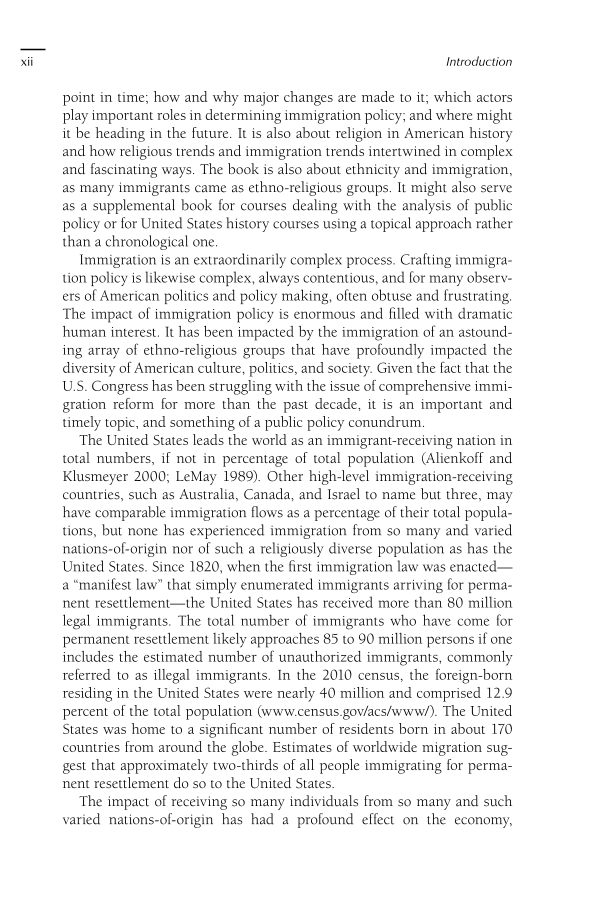xii Introduction point in time how and why major changes are made to it which actors play important roles in determining immigration policy and where might it be heading in the future. It is also about religion in American history and how religious trends and immigration trends intertwined in complex and fascinating ways. The book is also about ethnicity and immigration, as many immigrants came as ethno-religious groups. It might also serve as a supplemental book for courses dealing with the analysis of public policy or for United States history courses using a topical approach rather than a chronological one. Immigration is an extraordinarily complex process. Crafting immigra- tion policy is likewise complex, always contentious, and for many observ- ers of American politics and policy making, often obtuse and frustrating. The impact of immigration policy is enormous and fi lled with dramatic human interest. It has been impacted by the immigration of an astound- ing array of ethno-religious groups that have profoundly impacted the diversity of American culture, politics, and society. Given the fact that the U.S. Congress has been struggling with the issue of comprehensive immi- gration reform for more than the past decade, it is an important and timely topic, and something of a public policy conundrum. The United States leads the world as an immigrant-receiving nation in total numbers, if not in percentage of total population (Alienkoff and Klusmeyer 2000 LeMay 1989). Other high-level immigration-receiving countries, such as Australia, Canada, and Israel to name but three, may have comparable immigration fl ows as a percentage of their total popula- tions, but none has experienced immigration from so many and varied nations-of-origin nor of such a religiously diverse population as has the United States. Since 1820, when the fi rst immigration law was enacted— a “manifest law” that simply enumerated immigrants arriving for perma- nent resettlement—the United States has received more than 80 million legal immigrants. The total number of immigrants who have come for permanent resettlement likely approaches 85 to 90 million persons if one includes the estimated number of unauthorized immigrants, commonly referred to as illegal immigrants. In the 2010 census, the foreign-born residing in the United States were nearly 40 million and comprised 12.9 percent of the total population (www.census.gov/acs/www/). The United States was home to a signifi cant number of residents born in about 170 countries from around the globe. Estimates of worldwide migration sug- gest that approximately two-thirds of all people immigrating for perma- nent resettlement do so to the United States. The impact of receiving so many individuals from so many and such varied nations-of-origin has had a profound effect on the economy,
Document Details My Account Print multiple pages
Print
You have printed 0 times in the last 24 hours.
Your print count will reset on at .
You may print 0 more time(s) before then.
You may print a maximum of 0 pages at a time.




































































































































































































































































































































